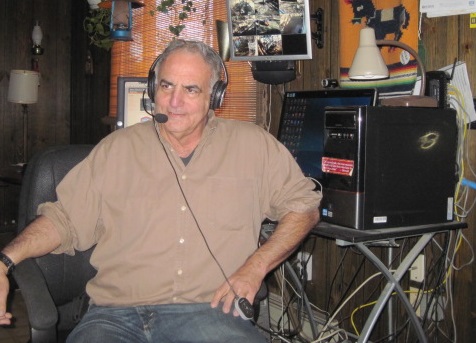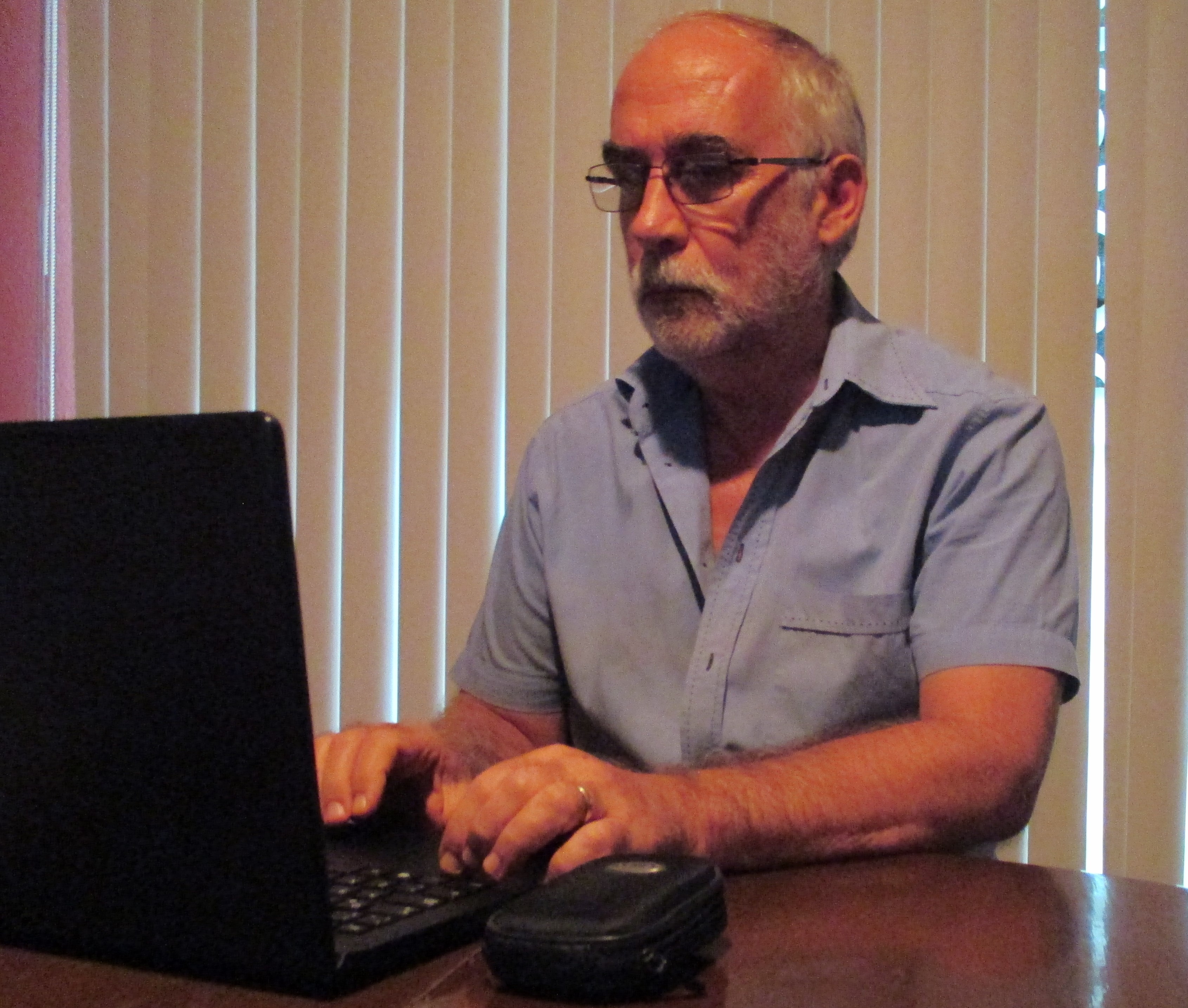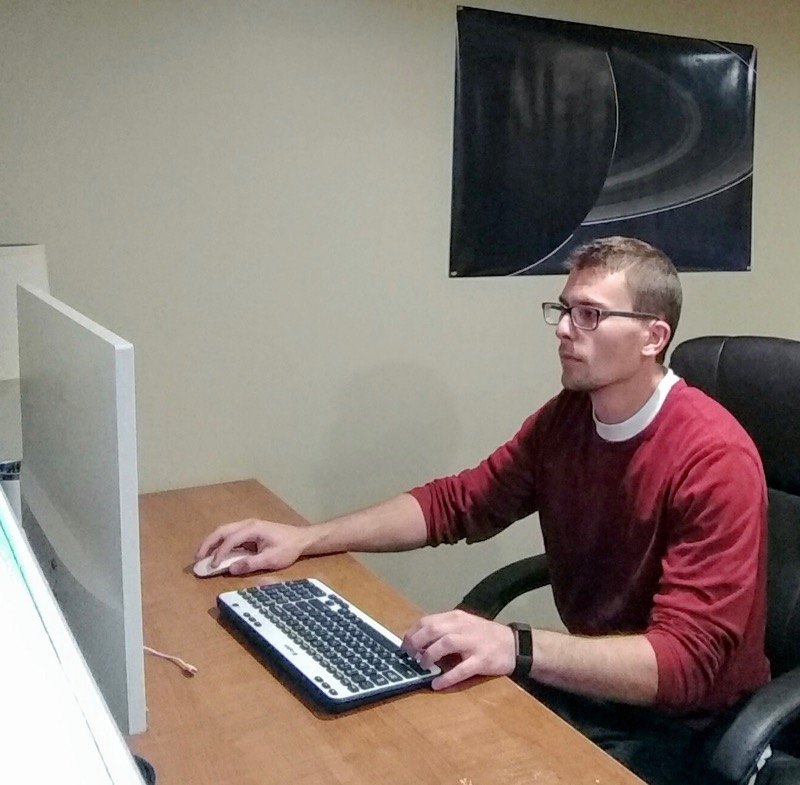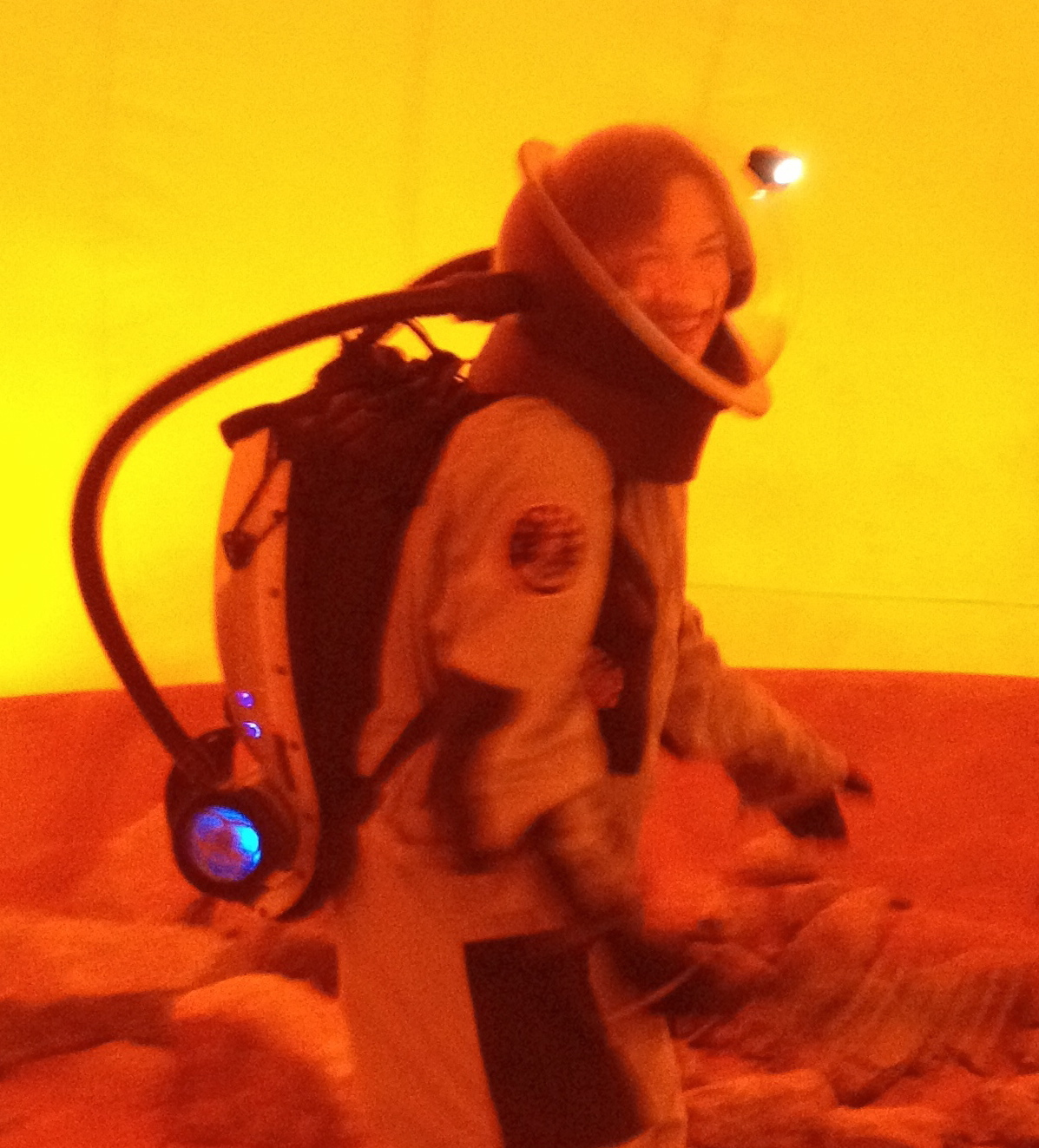A Mars 160 Crew Message: CapCom, We Hear You!
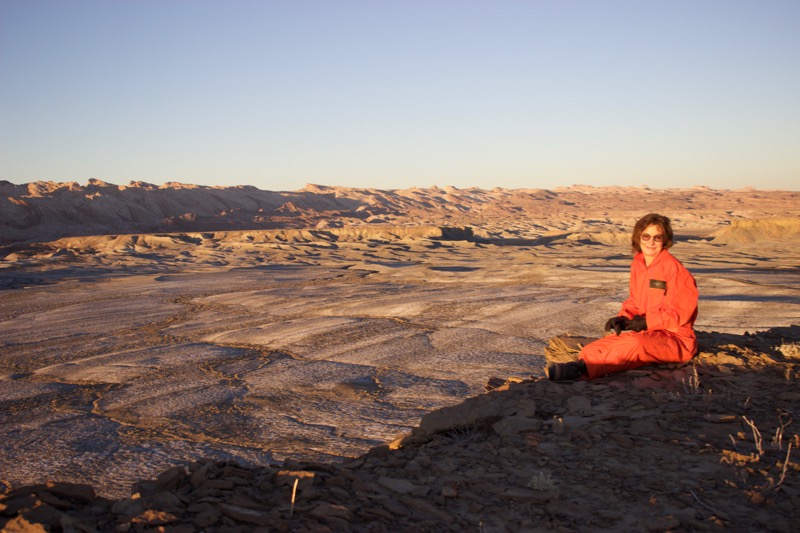
The Mars Society is conducting the ambitious two-phase Mars 160 Twin Desert-Arctic Analog missionto study how seven crewmembers could live, work and perform science on a true mission to Mars. Mars 160 crewmember Annalea Beattie is chronicling the mission, which will spend 80 days at the Mars Desert Research Station in southern Utah desert before venturing far north to Flashline Mars Arctic Research Station on Devon Island, Canada in summer 2017. Here's her seventh dispatch from the mission:
At the Mars Desert Research Station, at 7 p.m. sharp this evening, our Mars 160 Crew received a message from Capsule Communicator (CapCom): [See more Mars 160 photos here, and get daily images by the Mars 160 crew]
Greetings Mars 160 Commander and Crew,
CapCom is now signed on.
Deep Space Network acknowledges Acquisition of Signal at 1900 hours.
I'm Bernard, and I will be your CapCom for this evening from 1900-2100 hours Earth Mountain Time.
Your local Martian weather (temperatures Celsius, Winds km/h):
Breaking space news, the latest updates on rocket launches, skywatching events and more!
Tonight: Partly cloudy, with a low around -2. Southeast wind 6 to 11 km/h becoming light and variable in the evening.
Sunday: Sunny, with a high near 19. Calm wind.
Looking forward to your reports, updates and pictures.
Let me know if you have any questions. Thanks!
Best regards
Bernard Dubb, Capcom
This is Bernard, our person behind the scenes this week at CapCom. He's our MDRS IT coordinator, contributing to Mars Desert Research Station Hab networking, robotic observatory and autoponics projects.
I love this evening email from Bernard. It tells us Capcom is there every night from seven to nine p.m., ready to give us advice, send on reports and field all our queries.
We speak to someone from the CapCom each night. We depend on them, yet that person could be anywhere in the world and we never meet face to face.
Although they are the unseen and often the unheard part of our Mars 160 crew, CapCom team members are our "first point of contact," and key to Mission Support, not just for us but for every crew rotation at the Mars Desert Research Station in Utah.
A highly efficient, trained international team of officers, CapCom functions as an intermediary body between Crew and Mission Support specialists. As an essential part of MDRS operations, their volunteer work is often invisible. CapCom are Mission Support, not Mission Control. On Mars, the time delay for communications would make it impossible for CapCom to directly instruct us on something.
As Bernard says, "The CapCom Officer is the crew’s lifeline, whether if it’s how to test a battery, requesting fuel, food or water or to help coordinate the response to an injury."
The term "CapCom" was first used in the 1960s, when American astronauts were sent into space in capsules during the Mercury missions.
CapComs on real space missions are astronauts who represent both the control team on the ground and astronauts in space. One of the first good jobs an astronaut can get is to to be a CapCom. Traditionally, CapCom, for crews off-Earth, is someone who has had the experience of being an astronaut, someone who has insider knowledge and someone the crew knows. The CapCom on shift is primarily the one person who is allowed to talk to the crew in space so they are not confused by multiple voices.
As there is no room for error, CapComs train by carrying out simulations and becoming very familiar with science operations at Mission Control. For example, at NAS's Johnson Space Center in Houston, astronaut Cady Coleman is also a spacecraft communicator (CapCom). Here she is monitoring communications during the grapple and unberthing of Orbital ATK's Cygnus cargo ship, from the nadir port of the Harmony module on the International Space Station. [Private Antares Rocket & Cygnus Spacecraft Explained (Infographic)]
For Mars Desert Research Station CapComs, the training is both instructional and hands-on, in that CapCom officers are provided with a detailed manual, as well as opportunities to get guided experience. CapCom Miguel Cooper used to follow space shuttle missions on NASA TV. He says he learned a lot by observing the way a CapCom communicates with the crew in orbit. Miguel says looking at experienced CapComs is very useful when you are training.
So we know what happens from this end when the CapCom communication window opens, as we always have plenty to report — for instance, the Engineering report, Sol Summary, the Food Report, Journalist Report, Pictures, Science Posts, EVA Narratives etc. But what happens at the other end?
Anushree Srivastava, our biologist for Mars 160, is also a member of the CapCom team. She told me how it all works from the CapCom end of things.
CapCom logs in and greets the crew from Earth at the exact time when the CapCom window opens. As reports or queries are submitted by the crew, CapCom reviews them and forwards them on to Mission Support, then acknowledges the receipt of each report by replying to the crewmember.
After an hour, Capcom sends Mid-Com Notifications and asks if any other reports are to be sent. In the meantime, CapCom address questions and queries — for instance, crew problems such as water shortages, fuel problems, any health issues and so on.
Any issues not manageable by CapCom are forwarded to the respective experts. For example, an engineering query is sent to the Director of Engineering Projects, Judd Reed. CapCom plays a very important role in coordinating this conversation between crew and those experts.
When the CapCom window is about to close, Capcom sends out a notification of reports received and wishes everyone a good night's sleep. Then a passdown log is sent to Shannon Rupert (our director of the MDRS), to Ken Sullivan (CapCom Coordinator) and to Robert Zubrin (president of the Mars Society), to notify them of the most important issues to be addressed.
CapCom Gael Mariani lives in the United Kingdon, so she gets up at 2 a.m. to do her CapCom shift.
In her CapCom work room, there is a budgie called Io and a cat, and she has three dogs who sleep by her side and bark her awake when the alarms go off. (Her neighbors must love those late nights!) Gael is doing a degree in astronomy; she has her own observatory and loves astrophotography. She says no matter how familiar you become with the process of being a CapCom, nothing quite prepares you for the moment when you go "live" in your first solo stint, where you’re fully responsible for liaising with the crew onsite.
"It was a bit nerve-racking at first," she says, "but once you get a taste, you’re hooked."
As CapCom coordinator for the Mars Desert Research Station, Ken Sullivan is a past crewmember of MDRS Crews 149 & 165 and has extensive background and certifications with all things mechanical, especially concerning aircraft. Ken says those people with an interest in Mars quickly learn of the Mars Society and the Mars Desert Research Station. Many of the CapCom officers have previously served as crewmembers at the MDRS. And Ken says, "We all would love to be able to go back!"
For Ken, the most challenging part of the job is the cat-herding aspect. "Most explorers," he says, "are Type A personalities with strong minds, assertive personalities and determination. So when you have very smart people who are extremely capable, but the rules don’t allow certain things (for instance, legally you can’t recycle urine), then sometimes that frustrates the Crew. Some experiments are not allowed even though they seem quite harmless. Trying to get the Crew and Management to work together on all things creates some interesting psychology scenarios!" ['Mars: Our Future on the Red Planet' Examines Exploration Issues (Video)]
Many CapComs I spoke with told me that that the worst thing for them is when communications (i.e., the Internet) fail. Ken agrees, and says that's when "CapCom becomes an old mother hen, worried and continually checking to see if there are any communications from the Crew — anything to indicate that the Crew is well."
I'm always interested in working environments. Ken says all he needs is a notepad, a pencil and computer. He takes short notes while he reads reports and responds. Usually Ken is in his living room, with kids running around, while his imagination takes him to Mars.
CapCom Steve Knutson is an aspiring astronaut. As a scientist himself, he is always interested in the research done by astronauts in space. Steve would love to be aboard the International Space Station or on a lunar or Martian base investigating the effects of space travel on the human body. And he is fascinated by the technologies needed to help us work and live in space. I asked Steve about the most challenging aspect of CapCom.
Steve told me good time management skills are essential: "As a CapCom, you need to be very organized, and know how to prioritize and multitask. Multiple reports are coming in, and you need to review and forward them to the appropriate channels, all while keeping track of what you have received and recording details throughout the process. At the same time, you need to be able to answer crew questions and help solve problems, or reach out the correct personnel if you can’t individually help. It can be a really busy time during the communication window, and you have to stay focused."
CapCom Bruce Ngataierua and I were crewmates on Crew 118 (great team, Kiwi Mars). I asked Bruce about the kind of experiences he has had as CapCom to international crews.
He said, "I suppose one funny thing I recall about being online as CapCom is dealing with the different crews whose first language isn't English. I remember the Russian crew we had a few years ago, and sometimes they would forget to send their daily reports in English to me. I would have to translate some Russian words into English (using Google Translate — thank goodness!) and try and figure out what they were asking. We have had French and Japanese teams on board as well. This is part of the fun being a part of the CapCom team at MDRS."
At the very end of the interview questions I sent to the CapCom team, in the spirit of exchange I asked if anyone wanted to ask me something.
Our good relationship with CapCom is always conversational.
Here are my responses to a couple of questions.
First up: Capcom Coordinator Ken Sullivan asked me if I had read the CapCom manual, which is used to train new members of the team and has the protocols for working as a CapCom. And I can truthfully answer: Yes, Ken, I certainly have.
I have memorized it; you can test me later.
Steve Knutson asked how I became involved in the space realm and MDRS in general.
I became involved in the Mars Society in Australia because I'm an artist in love with space science. I'm always thinking about how art will evolve in hardy extraterrestrial societies living in frontier environments like Mars. The Mars Society gives me the opportunity to participate in space exploration, through art, media, in technology testing and as part of a science team.
It's such a great inclusive, exploratory organization.
Miguel asked me about the most valuable experience I've learned from this mission thus far as a Mars 160 crewmember.
What have I learned?
Something you all already know, CapCom: Always put the team first.
Mars or Enceladus?
(Just kidding, Robert.)
MARS OR BUST.
Annalea Beattie
Greetings Commander and Crew,
Reports received today:
1. Sol Summary Report #50 - Forwarded
2. Engineering Report – Reviewed
3. SSUIt project 4th entry – Forwarded
4. Technology Narrative – Forwarded
5. Phrase of the Day – Forwarded
6. Picture of the Day – Forwarded
7. Photo Report - Forwarded
If your report-to-be-posted is not listed here, please resend your report directly to me now.
This is my last evening as CapCom. Steve Knutson will be your CapCom starting tomorrow.
I’ve enjoyed communicating with you all and will be continuing in my role as MDRS IT Coordinator.
CapCom is now signing off for the evening.
Thanks for your communication during the Com Window and throughout the week.
Have a pleasant evening and an enjoyable day off tomorrow.
Please acknowledge this transmission.
"The purpose of life is the investigation of the Sun, the Moon, and the heavens."
— Anaxagoras, 459 BCE.
Best regards,
Bernard, CapCom
Editor's Note: To follow The Mars Society's Mars 160 mission and see daily photos and updates, visit the mission's website here: http://mars160.marssociety.org/. You can also follow the mission on Twitter @MDRSUpdates. For information on joining The Mars Society, visit: http://www.marssociety.org/home/join_us/.
Annalea Beattie is an artist and writer based in Melbourne, Australia, and her art practice is based on space science. She is a member of The Mars Society's Mars 160 Twin Desert-Arctic Analog mission, where her art-based research explores how observation is key to the role of all field geologists, including those on a planetary exploration crew. Follow The Mars Society on Twitter at @TheMarsSociety and on Facebook. Original article on Space.com.
